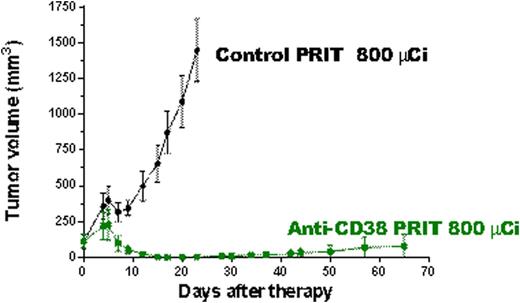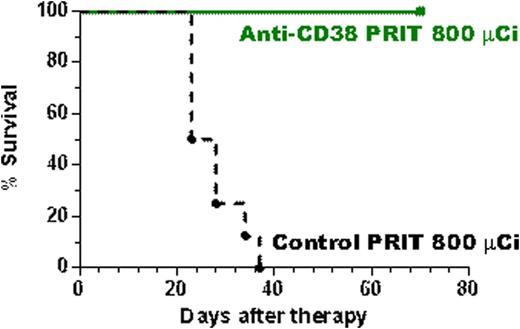Abstract
Novel therapies, including immunomodulatory agents (thalidomide, lenalidomide and pomalidomide) and proteasome inhibitors (bortezomib, carfilzomib) have improved response rates and prolonged progression free survival for patients with multiple myeloma (MM). Despite these advances the disease remains incurable. MM persistence is presumably due to residual malignant plasma cell clones that evade or develop resistance to available therapies. The efficacy of radioimmunotherapy (RIT) in the treatment of hematologic malignancies is well established and the radiosensitivity of malignant plasma cells has been demonstrated in both preclinical and clinical settings. CD38 is a plasma cell antigen that exhibits relatively specific, stable and uniform expression (95-100%) at a high epitope density on myeloma cells, making it an attractive target for antibody based therapies, including RIT. Recently, the unmodified CD38 mAb daratumumab has demonstrated anti-MM tumor cell activity both in vitro and in mouse xenografts, validating the antigen as a desirable target. Pretargeted RIT (PRIT), using a multi-step streptavidin (SA)-biotin targeting system enhances the therapeutic index of delivered radiation. We have generated an anti-CD38 antibody (Ab)-SA chemical conjugate (OKT10-SA). The OKT10-SA construct binds with high avidity to myeloma cells while retaining full biotin-binding capability for radiolabeled DOTA-biotin.
Blood, tumor and nonspecific organ uptakes of OKT10-SA directly measured in biodistribution experiments involving athymic nude mice bearing human MM xenograft tumors (Green, et al. ASH 2011) demonstrated tumor-to-normal organ ratios of absorbed radioactivity that were 8:1; 10:1; 8:1; and 6:1 respectively for blood, lung, liver and kidney in mice pretargeted with OKT10-SA; compared to 0.6:1; 0.9:1; 0.8:1 and 0.4:1 respectively, in control mice pretargeted with the IgG1 isotype matched control Ab BHV1-SA (bovine herpes virus-1).
In therapy studies athymic nude mice (n=9-10/group) bearing s.c. NCI-H929 human MM xenograft tumors received 1.4 nmol (300 µg) of either OKT10-SA (anti-CD38 SA) or BHV1-SA 22 hrs prior to synthetic biotin-acetyl-galactosamine clearing agent (CA; 5.8 nmol [50 µg]) and 24 hrs prior to 90Y-DOTA-biotin (2 µg) labeled with 800 µCi per mouse. Previously, a dose range of 800 µCi to 1200 µCi was identified as optimal when the high energy beta particle emitter 90Yttrium (t1/2 = 64 hrs) was used as the therapeutic radionuclide in a MM xenograft model (Green, et al. ASH 2011). All mice in the BHV1-SA control group experienced exponential MM tumor growth and 100% of these control animals required euthanasia within 37 days. All mice pretargeted with OKT10-SA demonstrated tumor shrinkage by day 6. After 70 days, 100% of the OKT10-SA treated animals remained alive and objective remissions were observed within 6 days in 100% of the mice treated with OKT10-SA followed by 800 µCi of 90Y-DOTA-biotin, including 100% complete remissions (no detectable tumor in OKT10-SA treated mice) compared to tumors that were 2982 ± 2834% of initial tumor volume [p<0.0001, Student’s t-test] in untreated control animals by day 23 [Figure]. Hepatic and renal function was assessed 160 days after mice received OKT10-SA followed by 90Y-DOTA-biotin (800 µCi, n=5) and no significant toxicity was observed. The measured serum creatinine was <0.4 mg/dl in all animals, the average BUN, ALT and AST values were 48 + 33 mg/dl, 46.8 +40 and 120.4 + 116.7 U/L respectively. The observed anti-tumor activity in this model was not attributable to an effector response mediated by the CD38 mAb in the absence of radiolabeled DOTA-biotin. Mice bearing MM xenografts (n=10) treated with OKT10-SA administered alone (without subsequent 90Y-DOTA-biotin infusion) demonstrated no objective tumor responses and 100% required euthanasia by day 17 for tumors that were 7837 ± 3492% of their initial volume. In a matched cohort of mice (n=10) treated concurrently with identical doses of OKT10-SA followed by CA and 90Y-DOTA-biotin (800µCi), 100% of the treated animals achieved a complete remission by day 17 and 70% of these animals were alive and tumor free at day 80.
No relevant conflicts of interest to declare.
Author notes
Asterisk with author names denotes non-ASH members.



